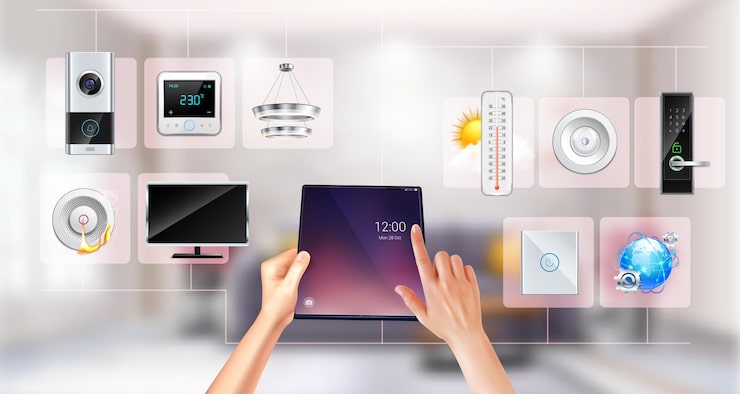Tech Home Automation is revolutionizing how we live, bringing convenience, efficiency, and intelligence into everyday life. From waking up to a perfectly brewed coffee to controlling lighting and temperature with a simple voice command, smart home systems are reshaping our routines. With devices becoming increasingly interconnected, managing your home has never been easier.
Imagine arriving home after a long day, and your living room lights adjust automatically, the thermostat sets your preferred temperature, and your favorite music starts playing—all without lifting a finger. This is the promise of Tech Home Automation, combining convenience with energy efficiency and comfort.
How Smart Devices Streamline Everyday Tasks
At the core of Tech Home Automation are smart devices designed to simplify repetitive tasks. Smart lighting, thermostats, security cameras, and voice assistants integrate seamlessly, allowing users to control their homes remotely. For example, automated lighting schedules can save energy while providing safety and convenience.
Consider a family using a smart fridge that tracks groceries and suggests recipes based on available ingredients. This small yet impactful innovation highlights how technology enhances everyday decision-making and saves time.
Energy Efficiency and Sustainability Benefits
Beyond convenience, home automation contributes significantly to energy efficiency. Smart thermostats learn user habits, adjusting heating and cooling patterns to minimize energy waste. Connected appliances operate at optimal times, reducing electricity costs and carbon footprint.
A real-life example is a homeowner who uses smart plugs and energy-monitoring apps to schedule appliances during off-peak hours. Not only does this lower monthly bills, but it also supports sustainable living practices, demonstrating that Tech Home Automation merges practicality with eco-consciousness.
Enhancing Home Security with Automation
Security is another critical aspect of smart homes. Automated door locks, surveillance cameras, motion sensors, and alarm systems provide peace of mind. Users can monitor their homes in real-time, receive alerts for unusual activity, and even grant temporary access to visitors remotely.
For instance, a parent at work can check their front door camera before letting a delivery person inside. This integration of security into daily routines exemplifies how Tech Home Automation strengthens safety while reducing stress and manual oversight.
Voice Control and Personalization
Voice-activated assistants such as Alexa, Google Assistant, or Siri allow homeowners to interact with devices naturally. Personalized routines can be set, like turning on morning lights, playing daily news, or starting a coffee maker simultaneously.
One tech-savvy user shared how their morning routine became seamless: lights gradually brighten at sunrise, curtains open, coffee brews, and music starts—all pre-programmed to their schedule. This personalization highlights how automation enhances quality of life through intuitive, user-centered design.
Integration Across Devices and Platforms
Modern smart homes rely on ecosystems where devices communicate through apps or hubs. Platforms like Apple HomeKit, Samsung SmartThings, or Amazon Alexa centralize control, simplifying management. Integration allows complex routines to execute automatically, such as lowering blinds and dimming lights for movie nights.
Families living in connected homes find that managing chores, energy consumption, and entertainment becomes effortless. This networked approach demonstrates the true potential of Tech Home Automation: a harmonious environment that adapts to lifestyle patterns.
Real-Life Examples of Daily Automation
Several households have adopted automation to optimize everyday routines. One working couple uses motion sensors to trigger lights only in occupied rooms, while smart speakers remind them of schedules and appointments. Another family automates garden irrigation based on weather forecasts, saving water and effort.
Even smaller interventions, like programmable coffee machines or voice-activated vacuum cleaners, illustrate the tangible benefits of automation in ordinary life. These stories showcase how technology enhances productivity and frees time for meaningful activities.
Preparing Homes for the Future
The evolution of Tech Home Automation continues with AI integration, predictive algorithms, and enhanced interconnectivity. Smart homes are becoming more intuitive, anticipating user needs and adjusting automatically.
For instance, AI-driven systems can learn your sleep patterns to adjust lighting and temperature for better rest or predict when appliances need maintenance. These innovations signify a shift from reactive automation to proactive home management, reinforcing convenience, efficiency, and comfort.
The Human-Centered Approach to Automation
Despite technological advancements, successful home automation focuses on human needs. Devices are designed to reduce cognitive load, streamline daily routines, and improve overall well-being.
From scheduling household chores to managing entertainment, Tech Home Automation demonstrates that smart systems are most effective when they complement human behavior, not replace it. Users benefit from increased control, convenience, and reduced stress, making technology an ally in everyday life.
Read also:
